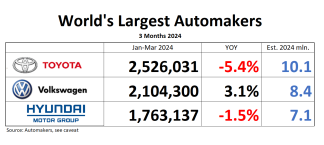I came home tonight, and Frau Schmitto-san, ever the caring wife, asked: “How was your day?”
“I was at Toyota, they launched a completely new line of gasoline engines, transmissions, drivelines.”
Frau Schmitto-san was perplexed: „They still make those?”
This about sums up the level of EV hype, and its utter disconnection from the truth. The short trip to Toyota was a journey back to reality.

Toyota Chief Powertrain Engineer Mitsumasa Yamagata (left) and his colleague Terasu Harashima (c)Bertel Schmitt
At Toyota’s Tokyo HQ, Chief Powertrain Engineer Mitsumasa Yamagata today reiterated Toyota’s goal to have half of its vehicles electrified by 2030, with the intent on full electrification by 2050. So far, so good. Other automakers, like Volkswagen, or Daimler, or Volvo announced similar bold electrification initiatives.
However, if one reads their statements closely instead of recklessly headlining that they announced an end of the internal combustion engine, one learns that their “electrification” is mostly a matter of semantics, and that it can mean anything from a very mild (and largely useless) 48v hybrid on up.
Toyota engineers can’t lie, and Yamagata charmingly laid out the shocking truth: “This means that even in 2030, 90% of our vehicles will be equipped with an internal combustion engine.” Why? Toyota believes that its share of battery electric vehicles (BEV) and fuel cell vehicles (FCV) will be around 10% by 2030. The bulk of Toyota’s electrification is seen going to hybrid, and plug-in hybrid vehicles. They need less gas, but gas they still need.
By 2050, Toyota wants to reach full electrification. On inspection of charts presented last December, one would see that close to 90% of this electrification is planned with hybrid and plug-in hybrid vehicles. More than 30 years from now, a vast majority of new vehicles will require gasoline. Cars live 20 years, or longer, and by that estimation, even the Millennials among us will not live to see the ultimate death of the ICE.
Toyota has been electrifying its cars since 1995, when it debuted its Prius. Other automakers, who just now are jumping on the electrified bandwagon after a big bet on diesel ended in disaster, likely will end up with an even bigger share of cars with internal combustion engines long into the future.
The armies of zombie internal combustion engines need to be made, and they need to be developed further. So today in Tokyo, Toyota introduced technology Frau Schmitto-san and many investment analysts presumed as dead. To a huge crowd of journalists, Toyota introduced a brand-new 2.0-liter gasoline engine, two new transmissions (one manual, one CVT) and a new 4WD drive system to be powered by a gasoline engine. A new hybrid system for 2.0-liter engines was also introduced. The official release will explain everything in detail.
At the event, a devoted BEV disciple would have felt like a vegan abducted to the Meatpacking District: There were animations of exploding fossil fuels, long discussions of gears and pulleys, and ominous slides announcing the “development of 19 new powertrain models by end of 2021.” All of them needing gasoline. Toyota thinks that zero emissions is a noble objective, but until that’s viable, we should lower emissions as much as possible. By rolling out its new powertrains, Toyota expects a reduction of CO2 emissions better than 18%.
Research into ICE powertrains is on-going at Toyota, Yamagata said, and R&D budgets are unchanged. This pours water on theories of lost “sunk costs” into ICE technology. If by 2050 some 90% of all new cars still need gasoline, as Toyota believes, new investments like what we saw today will be amortized many times over. And speaking of investments, if Toyota is right about its projections (and one doesn’t become world’s largest automaker by making too many wrong bets) giddy investors pouring money into BEV-only upstarts need to revise their spreadsheets: With the market for battery-electric vehicles limited to a few million a year for decades, BEV-only upstarts will be trampled by incumbents who can sell traditional cars to pay the bills. Sure, Toyota made these projections only for itself, and not for the general market, but at its size and global reach, Toyota should be quite a decent proxy.
“It looks like the combustion engine will be with us longer than we imagine,” I told Frau Schmitto-san, and she fed me dinner.






